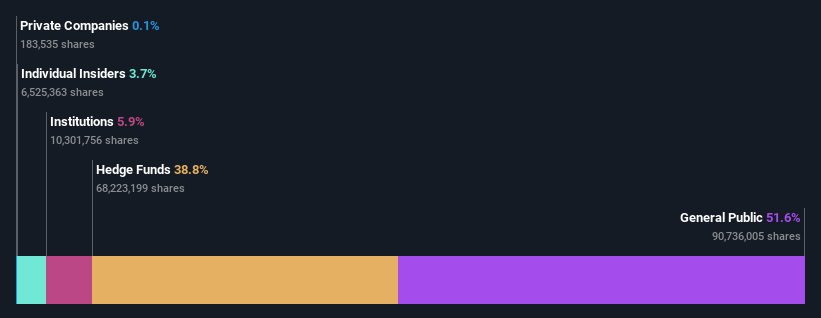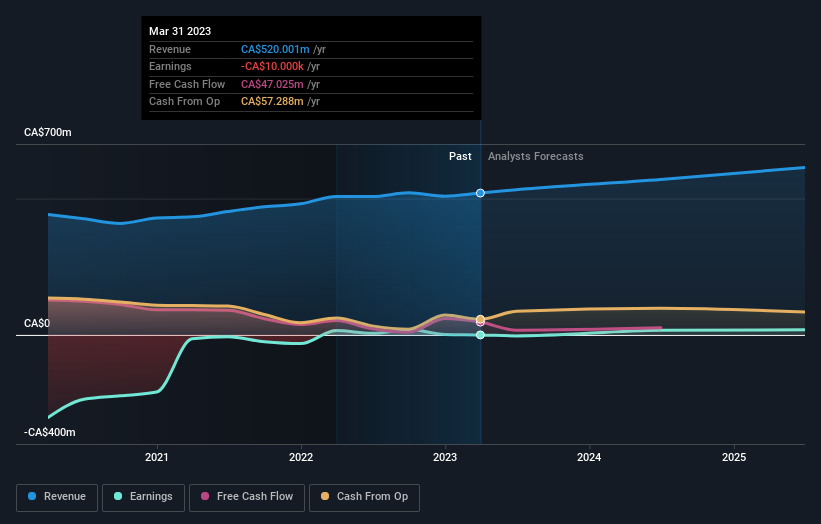- Canada
- /
- Entertainment
- /
- TSX:WILD
WildBrain Ltd.'s (TSE:WILD) biggest owners are retail investors who got richer after stock soared 14% last week

Key Insights
- WildBrain's significant retail investors ownership suggests that the key decisions are influenced by shareholders from the larger public
- The top 25 shareholders own 48% of the company
- Insiders have sold recently
A look at the shareholders of WildBrain Ltd. (TSE:WILD) can tell us which group is most powerful. And the group that holds the biggest piece of the pie are retail investors with 50% ownership. Put another way, the group faces the maximum upside potential (or downside risk).
As a result, retail investors were the biggest beneficiaries of last week’s 14% gain.
Let's take a closer look to see what the different types of shareholders can tell us about WildBrain.
See our latest analysis for WildBrain

What Does The Institutional Ownership Tell Us About WildBrain?
Institutional investors commonly compare their own returns to the returns of a commonly followed index. So they generally do consider buying larger companies that are included in the relevant benchmark index.
As you can see, institutional investors have a fair amount of stake in WildBrain. This can indicate that the company has a certain degree of credibility in the investment community. However, it is best to be wary of relying on the supposed validation that comes with institutional investors. They too, get it wrong sometimes. It is not uncommon to see a big share price drop if two large institutional investors try to sell out of a stock at the same time. So it is worth checking the past earnings trajectory of WildBrain, (below). Of course, keep in mind that there are other factors to consider, too.

It looks like hedge funds own 38% of WildBrain shares. That worth noting, since hedge funds are often quite active investors, who may try to influence management. Many want to see value creation (and a higher share price) in the short term or medium term. Our data shows that Fine Capital Partners, L.P. is the largest shareholder with 39% of shares outstanding. PRIMECAP Management Company is the second largest shareholder owning 3.4% of common stock, and Eric Ellenbogen holds about 1.1% of the company stock.
A deeper look at our ownership data shows that the top 25 shareholders collectively hold less than half of the register, suggesting a large group of small holders where no single shareholder has a majority.
While studying institutional ownership for a company can add value to your research, it is also a good practice to research analyst recommendations to get a deeper understand of a stock's expected performance. There are plenty of analysts covering the stock, so it might be worth seeing what they are forecasting, too.
Insider Ownership Of WildBrain
The definition of company insiders can be subjective and does vary between jurisdictions. Our data reflects individual insiders, capturing board members at the very least. Management ultimately answers to the board. However, it is not uncommon for managers to be executive board members, especially if they are a founder or the CEO.
I generally consider insider ownership to be a good thing. However, on some occasions it makes it more difficult for other shareholders to hold the board accountable for decisions.
Shareholders would probably be interested to learn that insiders own shares in WildBrain Ltd.. As individuals, the insiders collectively own CA$13m worth of the CA$364m company. It is good to see some investment by insiders, but it might be worth checking if those insiders have been buying.
General Public Ownership
The general public -- including retail investors -- own 50% of WildBrain. This level of ownership gives investors from the wider public some power to sway key policy decisions such as board composition, executive compensation, and the dividend payout ratio.
Next Steps:
It's always worth thinking about the different groups who own shares in a company. But to understand WildBrain better, we need to consider many other factors. To that end, you should be aware of the 2 warning signs we've spotted with WildBrain .
If you are like me, you may want to think about whether this company will grow or shrink. Luckily, you can check this free report showing analyst forecasts for its future.
NB: Figures in this article are calculated using data from the last twelve months, which refer to the 12-month period ending on the last date of the month the financial statement is dated. This may not be consistent with full year annual report figures.
Valuation is complex, but we're here to simplify it.
Discover if WildBrain might be undervalued or overvalued with our detailed analysis, featuring fair value estimates, potential risks, dividends, insider trades, and its financial condition.
Access Free AnalysisHave feedback on this article? Concerned about the content? Get in touch with us directly. Alternatively, email editorial-team (at) simplywallst.com.
This article by Simply Wall St is general in nature. We provide commentary based on historical data and analyst forecasts only using an unbiased methodology and our articles are not intended to be financial advice. It does not constitute a recommendation to buy or sell any stock, and does not take account of your objectives, or your financial situation. We aim to bring you long-term focused analysis driven by fundamental data. Note that our analysis may not factor in the latest price-sensitive company announcements or qualitative material. Simply Wall St has no position in any stocks mentioned.
About TSX:WILD
WildBrain
Engages in the development, production, and distribution of films and television programs in Canada, the United States, the United Kingdom, and internationally.
Fair value with mediocre balance sheet.
Similar Companies
Market Insights
Community Narratives



